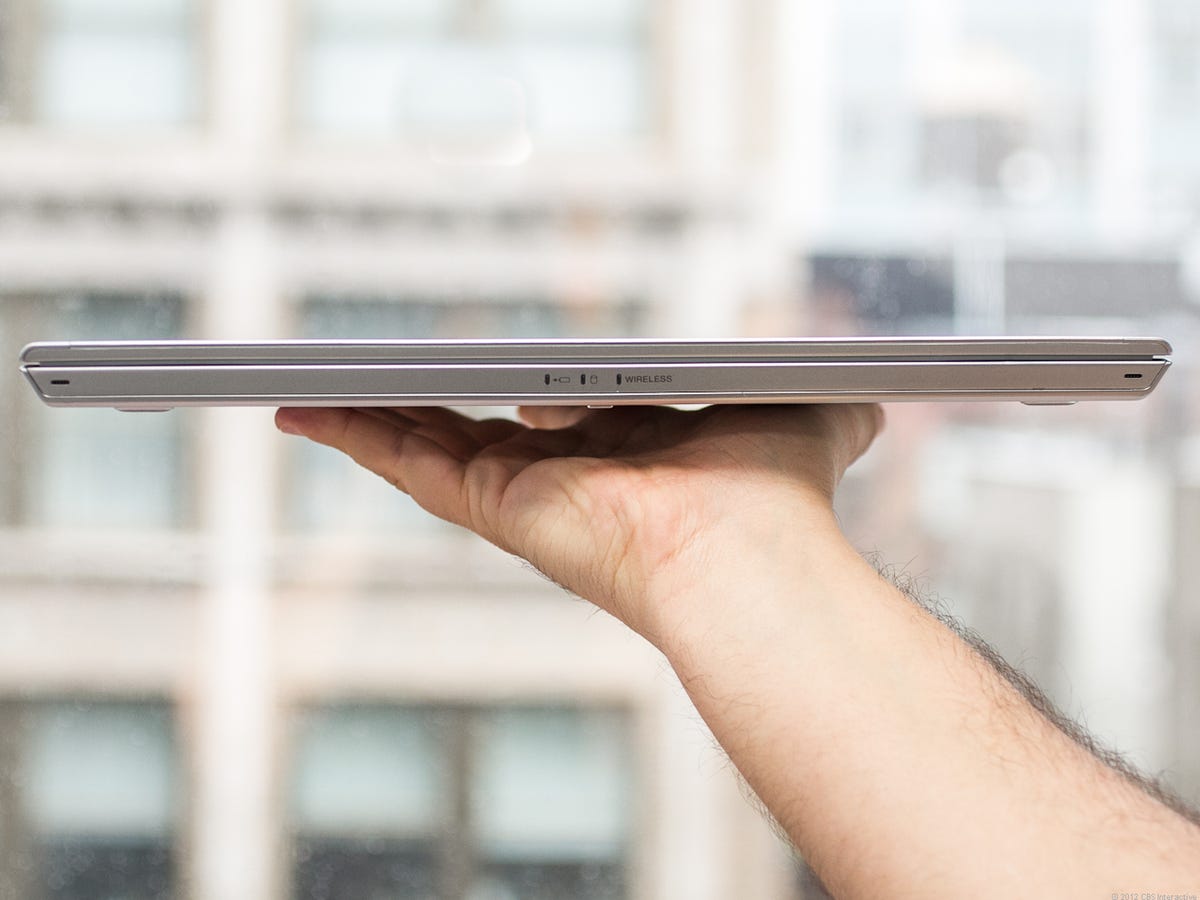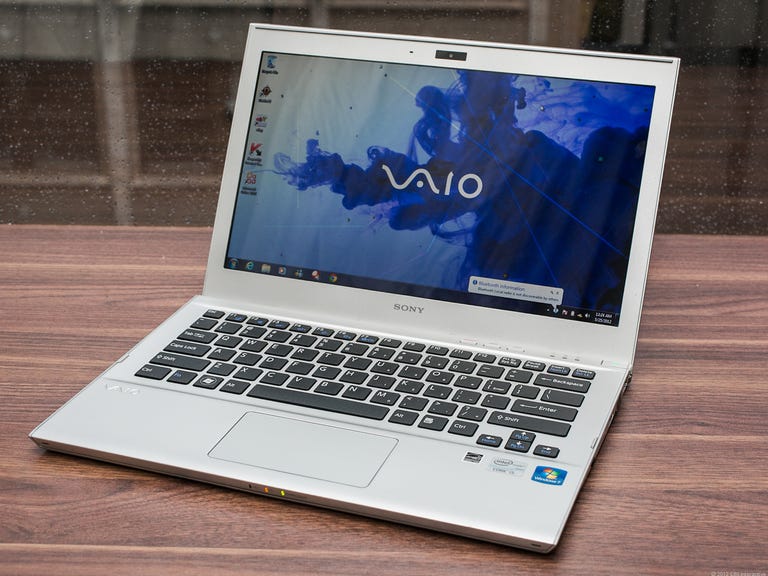 Why You Can Trust CNET
Why You Can Trust CNET Sony VAIO T review: Sony VAIO T
Sony's first ultrabook, the Vaio T, doesn't fall far from the tree of other thin Sony laptops like the Vaio Z, but it's far more affordable: this is ultrabook-as-budget-laptop, not ultrabook as high-end computer.
In 2012, ultrabooks are everywhere. Ostensibly, they're thinner, lighter, possibly more stylish laptops. And, as of late, they're pretty affordable, too. The average Windows ultrabook may have achieved MacBook Air-level prices in 2011, but this year prices have dropped to fit a landscape of more budget-minded Windows computers. Sony, one of the few laptop manufacturers to have skirted the ultrabook wave thus far, has finally unveiled its own in the Sony Vaio T, and counter to the usual trend of Sony Vaios being more expensive devices, this one stays at the affordable end of the spectrum: an entry-level Vaio T costs $799.

The Good
The Bad
The Bottom Line
The more pressing question is this: does a Vaio ultrabook make sense? Sony actually has several quite capable thin laptops in its stable: the Vaio S line, and the nosebleed-expensive
A lower-voltage third-gen Ivy Bridge Intel processor and no optical drive seem like compromises compared to last year's Vaio S, which had practically the same thickness, and started at the same price: $799. The Vaio T's thicker than some ultrabooks, but it's really more of an affordable, spiritual variation of the Vaio Z, with ultrabook branding.
If you've always wanted a Vaio Z but couldn't afford one, maybe the Vaio T will make your dreams come true. Truth be told, it's a good Sony debut ultrabook, but not really a very surprising one.
| Price as reviewed | $799 |
| Processor | 1.7GHz Intel Core i5-3317U |
| Memory | 4GB, 1,333MHz DDR3 |
| Hard drive | 500GB 5,400 HDD hybrid with 32GB SSD |
| Chipset | Intel HM77 |
| Graphics | Intel HD 4000 |
| Operating system | Windows 7 Home Premium (64-bit) |
| Dimensions (WD) | 12.7x8.5 inches |
| Height | 0.7 inch |
| Screen size (diagonal) | 13.3 inches |
| System weight / Weight with AC adapter | 3.4 pounds / 3.9 pounds |
| Category | ultrabook |
Glance at the aluminum-and-plastic chassis of the Vaio T13112 FXS and you'll have a hard time seeing the difference between it and a Vaio S, or a Vaio Z. A Vaio-loving colleague assumed it was an S at first glance. The trapezoidal wedge-shaped profile is nearly identical to the last Vaio Z we reviewed: about the same thickness, with a deeper footprint. The top lid, like the Vaio Z, has a downright bizarre hinge: tucked to the rear and covered in a flimsy-feeling chromed plastic, the back lid opens up and pushes down on the rear of the Vaio T, thrusting the keyboard up a bit. Ergonomic or annoying? I side with annoying.
The wide island-style keyboard has generous key spacing, but some of the shallowest keys I've ever typed on. They nearly feel painted on. The Vaio Z had similar keys, but backlit. Thin laptops like the MacBook Air have shallow keys, too, but usably so. The Vaio T crosses the line, and the typing comfort on this Vaio ultrabook suffers for it. Also, there's no backlight: Sony claimed that the reason was that there was no room in the ultrabook's thin design, but this ultrabook is thicker than others I've seen. There's no good reason for keyboard compromise like this.
Below is a slightly recessed multitouch click pad, reasonably wide and tall enough and with good sensitivity, but the touch pad could have been made bigger to fit the space available. The slight recessing also makes bottom clicks just a tad harder to do when your thumb's lying on the slightly higher palm rest.
Above the keyboard are a few dedicated keys: Assist, Web, and Vaio. Assist launches Vaio Care, a service for diagnosing and fixing problems, while Web launches your Web browser of choice and Vaio launches Media Gallery or PlayMemories, part of Sony's music and photo software that comes preinstalled.
The 13.3-inch glossy-coated display's inset in a thick silver bezel, with a 1,366x768-pixel native resolution. That's standard for this size, but the Vaio's screen, while bright, didn't seem as vivid or colorful as you'd expect from a Sony product. Viewing the screen off-axis at vertical and horizontal angles produced washed-out results. It's not a showcase screen.
Front-firing stereo speakers are tucked onto the Vaio T's thick front edge, emitting sound via a small hole on each side. Sound quality is a little tinny, but louder than a MacBook Air by about a factor of two. Movies and video chats are, at the very least, quite audible.
Speaking of Web chat, the included. Arcsoft Webcam Companion 4 and Skype are both preinstalled and can be launched from the Vaio Gate pull-down dock at the top of the screen. The 1,280x1,024-pixel-resolution camera demonstrated good contrast and light sensitivity in my office.
| Sony Vaio T13112FXS | Average for category [ultrabook] | |
|---|---|---|
| Video | HDMI, VGA | VGA plus HDMI or DisplayPort |
| Audio | Stereo speakers, headphone/microphone combo jack | Stereo speakers, headphone/microphone jacks |
| Data | 1 USB 3.0, 1 USB 2.0, SD card reader, memory card reader | 2 USB 2.0, 1 USB 3.0, SD card reader |
| Networking | Ethernet, 802.11n Wi-Fi, Bluetooth | Ethernet, 802.11n Wi-Fi, Bluetooth, optional mobile broadband |
| Optical drive | None | None |
The Vaio T13112FXS covers the necessary bases on ports and connections, including everything that I look for in an ultrabook: USB 3.0, HDMI, an Ethernet port, Bluetooth, and an SD card slot. The USB ports are limited here, but no more so than most ultrabooks.
The fixed $769 configuration of the Vaio T13112FXS I reviewed has 4GB of RAM, a 1.7 GHz third-gen Core i5-3317U processor, and a 500GB hybrid hard drive with an additional 32GB SSD. Including hybrid hard drives with larger storage capacities and small amounts of fast-loading SSD flash storage instead of more expensive full-size SSDs is a trend you can bank on seeing on many budget ultrabooks this year: it cuts the cost of the system, and arguably offers the benefit of more space for your media. I prefer hybrid hard drives until SSDs can get large enough (256 or 512GB) to avoid compromise. The 4GB of RAM can be expanded to 8GB.
This is the first third-gen Intel Ivy Bridge ultrabook I've reviewed, and the experience was positive, if somewhat uninspiring. The 1.7 GHz Core i5-3317U processor compared favorably to the Intel ultrabook "white box" we received at CNET, which had a slightly faster and better-performing 1.8 GHz Core i5-3427U processor. It performed more slowly on benchmark tests than the
Compared to ultrabooks with Sandy Bridge second-generation Intel processors, there's a definite but modest improvement. The Vaio T13112FXS performed better than the 13-inch Samsung Series 5 Ultra we recently reviewed, the
Boot-up times were reasonably quick -- about 27 seconds by my stopwatch -- but not as fast as on an SSD laptop like the Samsung Series 9 or MacBook Air. The Vaio T woke from sleep more rapidly, taking about 3 seconds. It's still a zippy machine, even if its boot times don't rock your socks off.
Graphically, however, I was a bit disappointed. Intel's much-heralded improved HD 4000 integrated graphics provide an improvement over last year's HD 3000 graphics, but it didn't seem like a quantum leap on this ultrabook. Street Fighter IV played at 15.1 frames per second at native 1,366x768 resolution and 2x AA. One of the first ultrabooks with a hybrid hard drive we reviewed last year, the Acer Aspire S3, ran that same SFIV test at 11.9 fps. That's not exactly a massive leap, and it doesn't get this laptop to the point where it can play mainstream PC games easily, or even well. Diablo III ran at about 16 frames per second with graphics set to low. Quad-core Ivy Bridge CPUs exhibited better graphics performance, but it's a different story here in ultrabook-land. (The Intel white box played Street Fighter IV at 21 frames per second).
The Vaio T13112FXS's integrated battery ran well, topping 5 hours and 42 minutes in our battery-drain test. That beats out ultrabooks like the
Sony includes a standard one-year warranty, which can be upgraded at the time of purchase. The new Vaio T wasn't live on Sony's Web site at the time this review was written, so the price for extended service plans isn't known (the T is a new line).
Sony's first ultrabook, the Vaio T, is really more of a budget-themed Vaio Z with some corners cut and a slightly larger body. Because of that and its affordable $799 entry price, it's a success: however, it's not a slimmer or more revolutionary product compared to other Vaios. For the first time I can remember, the ultrabook isn't the classiest or best thin laptop in a laptop manufacturer's stable.
(Shorter bars indicate better performance)
(Shorter bars indicate better performance)
(Shorter bars indicate better performance)
(Longer bars indicate better performance)


